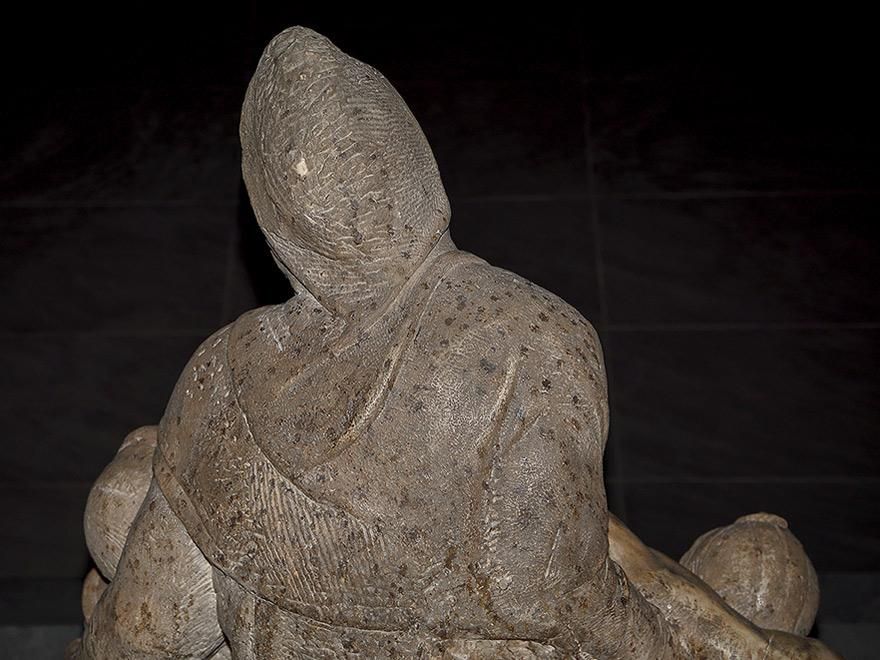Visitors Can Watch the Restoration of Michelangelo’s ‘Bandini Pietà’
The artist once took a sledgehammer to the sculpture, which is now housed at a museum in Florence
/https://tf-cmsv2-smithsonianmag-media.s3.amazonaws.com/filer/36/ae/36ae07db-e929-4ff9-a123-4070581fdf0a/pieta.jpg)
In the roughly 470 years since its creation, layers of smoke, candle wax, dirt and plaster have accrued on Michelangelo’s Bandini Pietà, also known as La Pietà or the Deposition. Soon, however, the Renaissance masterpiece will be restored from a dingy, darkened sculpture to its former alabaster glory.
As the Bandini Pietà’s long-time home, Florence’s Museo dell’Opera del Duomo, announced earlier this week, conservators will restore the famed statue in full view of visitors. Per the Art Newspaper’s Nancy Kenney, the restoration project is expected to continue through summer 2020.
The sculpture in question isn’t Michelangelo’s most famous Pietà. Unlike its better-known counterpart—housed at St. Peter’s Basilica in Rome, the sculpture depicts the Virgin Mary cradling her crucified son in her lap—this Florentine version shows either Nicodemus or Joseph of Arimathea helping the Virgin Mary and Mary Magdalene remove Christ’s body from the cross.
“People come from all over the world to see it, so it’s a shame to hide it during restoration,” Paola Rosa, head of the restoration project, tells the Times’ Tom Kington.
According to a press release, the team hopes to remove the sculpture’s dark patina to restore a sense of three-dimensionality. Although the Bandini Pietà acquired several nicks and scars during its transport from one location to another, the statement attributes the majority of the work’s discoloration to the millions of visitors who have filed through the museum’s halls over the years, introducing dust, lint and humidity into the space.
The Art Newspaper reports that the museum has constructed a small stage around the sculpture to ensure visitors can watch each meticulous step of the restoration. To begin, the team will conduct a complete assessment of the sculpture, identifying all of the spots where it is scarred or broken. The conservators will also use ultraviolet light to find candle wax smears and traces of plaster deposited on the statue’s surface when a cast was made in the late 19th century.
Next, the team will tackle the Bandini Pietà’s discoloration.
“The dirt is the first issue,” says Timothy Verdon, director of the Museo dell’Opera del Duomo, to Kenney. “As far as we can judge, it has never had an in-depth cleaning.”
Verdon notes that it may not be possible to restore the sculpture to bright white, as some of the discoloration likely stems from the quality of marble used.
He says, “Michelangelo’s other statues were carved in good Carrara marble, but this is bad Carrara marble.”
The researchers hope to test a chunk of the marble to identify the quarry where it originated.

Despite the fact that the Bandini Pietà is covered in dirt and unfinished, Verdon describes it as one of Michelangelo’s greatest creations.
“The most suitable wording for it,” he adds, “would be that of the 16th century, when it was still called an infinite work.”
Per ANSA’s Niccolò Gramigni, Michelangelo worked on the sculpture between 1547 and 1555, when he was nearing the age of 80 years old. The artist created the work to adorn the chapel in which he would eventually be buried; the figure of Nicodemus or Joseph of Arimathea represents a rare self-portrait of the sculptor.
Michelangelo worked on the Bandini Pietà at night after toiling away his days as the architect of St. Peter’s Basilica. He was dissatisfied with the project, saying the hard marble made his chisel spark. When the sculpture was nearly finished, the artist realized that adding Christ’s left leg would destroy the work’s composition, so he decided to leave it incomplete. But Michelangelo didn’t simply abandon the work: Instead, he attempted to destroy it, using a sledgehammer to damage Christ’s leg and knock off his arm and hand.
The frustrated sculptor sold or gifted the unfinished, damaged work to wealthy businessman Francesco Bandini, who hired Michelangelo’s student Tiberio Calcagni to repair and finish the piece. The sculpture was installed in various churches before its transfer to the Duomo museum in 1981.
According to Kington, the researchers hope to test the restored arm to determine whether Calcagni was able to reattach Michelangelo's original or if he had to sculpt an entirely new arm.
Michelangelo died in 1564 at the age of 88. He was buried in an elaborate tomb at Florence’s Church of Santa Croce. The memorial, designed by artist Giorgio Vasari, includes paintings, a bust of Michelangelo, and figures celebrating painting, sculpture and architecture. None of the works seen on the tomb are by the artist himself.